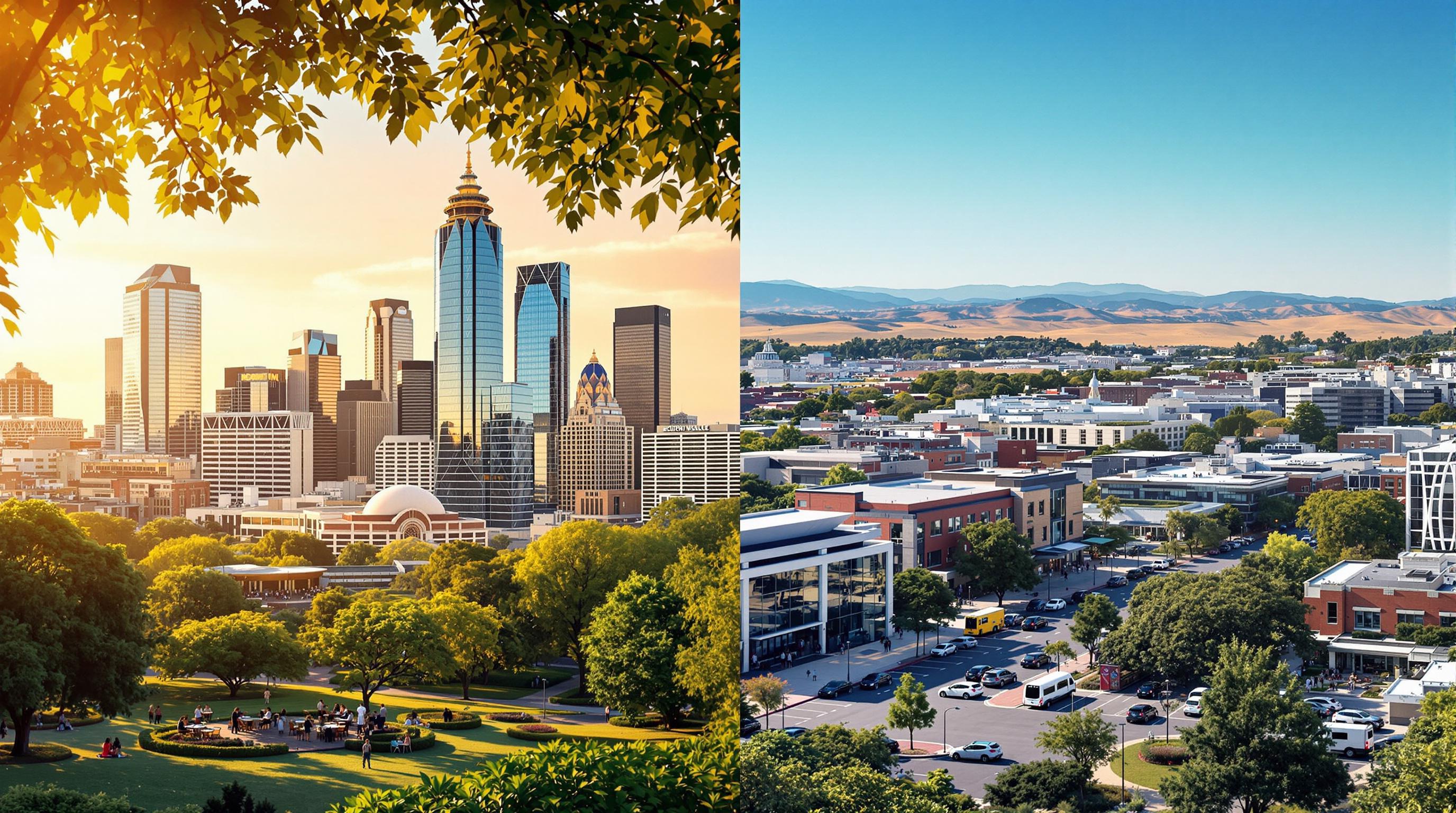Austin and Silicon Valley are two of the top tech hubs in the U.S., but they offer very different opportunities for startups, professionals, and investors.
Here’s a quick comparison:
- Silicon Valley has a larger tech workforce (378,000 workers), higher salaries ($175,000 median), and access to more venture capital from firms like Andreessen Horowitz.
- Austin is growing faster (8.7% annual tech job growth), offers lower costs of living and business, and provides tax benefits like no state income tax.
| Metric | Silicon Valley | Austin |
|---|---|---|
| Tech Workforce Size | 378,000 | 172,000 |
| Annual Growth Rate | 4.2% | 8.7% |
| Median Tech Salary | $175,000 | $125,000 |
| Major Employers | Google, Apple, Meta | Tesla, Oracle, Dell |
| Median Home Price | $1.2M+ | Lower, more affordable |
Key Takeaway: Silicon Valley dominates in funding and established networks, while Austin excels in affordability, faster growth, and a better work-life balance. Whether you prioritize career opportunities or quality of life, both cities have distinct advantages.
Startup Growth and Support
Active Startups by Region
Silicon Valley stands out as a major hub for startups, especially in sectors like artificial intelligence and biotechnology. It’s home to both established tech giants and up-and-coming companies.
Austin’s startup scene has expanded significantly, creating an entrepreneur-friendly environment. While the density of startups differs between the two regions, this contrast also shapes their investment landscapes.
Investment Access
Silicon Valley has a long-standing network of venture capital firms, including Andreessen Horowitz and Sequoia Capital, which provide consistent and substantial funding options for startups.
Austin’s venture capital network has grown steadily over time. Although funding levels in Austin are generally more modest, lower operating costs mean that investments often go further. These differences in funding availability influence the resources and business support startups can access in each region.
Business Support Programs
Both areas provide strong support systems for entrepreneurs, but their approaches differ. In Silicon Valley, accelerators like Y Combinator and 500 Startups are known for their intensive programs and significant initial funding.
Austin focuses on community-driven support and accessibility. Programs like Capital Factory and university-led incubators have been instrumental in helping early-stage companies thrive. Combined with the city’s lower costs, these initiatives create an environment where startups can establish a solid base for growth.
Tech Workforce
Tech Employee Numbers
Silicon Valley leads the U.S. in tech employment, with 378,000 tech workers across the San Francisco and San Jose metro areas as of early 2025. Despite recent layoffs, the region has seen a 4.2% annual increase in tech jobs.
Austin, meanwhile, has a tech workforce of 172,000 as of Q1 2025, growing at an impressive 8.7% each year. This growth is fueled by companies like Tesla, Oracle, and Dell relocating or expanding their operations in the area. Median salaries for tech roles in Austin average $125,000, compared to $175,000 in Silicon Valley.
| Metric | Silicon Valley | Austin |
|---|---|---|
| Tech Workforce Size | 378,000 | 172,000 |
| Annual Growth Rate | 4.2% | 8.7% |
| Median Tech Salary | $175,000 | $125,000 |
| Major Tech Employers | Google, Apple, Meta | Tesla, Oracle, Dell |
Both regions benefit from strong academic institutions that help sustain their tech workforces.
Local Universities
The University of Texas at Austin produces over 1,200 computer science graduates annually. Its Computer Science program is highly ranked, and a partnership with Dell Technologies has resulted in a $160 million investment in AI research facilities.
In Silicon Valley, Stanford University and UC Berkeley together graduate about 2,500 computer science students each year. Stanford’s close relationships with major tech companies create a collaborative environment, with 65% of its computer science graduates staying in the Bay Area.
Employee Retention
The average tech worker in Silicon Valley stays with an employer for 23 months. Long commutes – averaging 45 minutes – and sky-high median home prices of over $1.2 million contribute to this shorter tenure. In Austin, the average tenure is longer at 32 months, supported by lower living costs and shorter commutes. Austin companies also report a turnover rate about 15% lower than that of Silicon Valley.
These differences highlight the unique challenges and advantages of each region. While Silicon Valley remains a hub for cutting-edge tech, Austin’s growing ecosystem is becoming an attractive, sustainable choice for both employees and employers.
Business and Living Expenses
Home Prices and Rent
Austin’s housing market offers a more budget-friendly option compared to Silicon Valley, where property values are notoriously high. In Austin, both buying a home and renting are less expensive, which helps reduce costs for employees and businesses alike. This affordability means Austin residents generally spend a smaller portion of their income on housing.
Business Costs
Running a business in Austin comes with noticeable savings. Office space in Austin’s key tech areas is less expensive than in Silicon Valley. Utility bills are often lower too, making it easier to manage daily operations. These cost reductions can create room for additional financial flexibility.
Tax Benefits
Texas provides another advantage: no state income tax. This benefits both individuals and businesses. While Silicon Valley companies may deal with lower property tax rates, the high property values in the area often lead to a heavier tax burden. Overall, Austin’s tax structure tends to be more business-friendly.
Lower housing costs, reduced operational expenses, and a favorable tax environment can significantly impact a company’s ability to grow. Businesses moving to or expanding in Austin often find they can redirect funds toward areas like research, development, or hiring top-tier talent. For more detailed insights, resources like Austin Local Team can help navigate the market.
sbb-itb-4c99469
Lifestyle Comparison
Daily Life
Austin offers a more laid-back lifestyle with shorter commutes and a relaxed work culture compared to Silicon Valley’s longer workweeks. Outdoor activities are a big part of life in Austin, thanks to places like Lady Bird Lake Trail and Barton Springs Pool. With plenty of sunshine and mild winters, the city encourages an active, outdoor-focused lifestyle. On top of that, each city’s cultural and social venues add to their unique character.
Entertainment Options
Austin thrives on its vibrant cultural scene, hosting events like SXSW and Austin City Limits. The city’s 6th Street and its many eclectic venues reflect its lively and creative atmosphere. Meanwhile, Silicon Valley leans toward upscale entertainment, featuring top-tier restaurants and luxury shopping destinations such as the Stanford Shopping Center. Being close to San Francisco adds even more cultural options, though heavy traffic can sometimes make them harder to access.
Business Networks
Professional networking plays a key role in both cities, though their approaches differ. Austin’s networking scene is more casual, with tech meetups and events often held at spots like Capital Factory. Areas like The Domain and South Congress also naturally bring professionals together.
Silicon Valley, on the other hand, remains a global hub for tech networking. Organizations such as Y Combinator and the venture capital firms on Sand Hill Road anchor the region’s professional ecosystem. Austin also supports startups and entrepreneurs through events like Austin Startup Week and meetings organized by the Austin Technology Council, fostering meaningful connections.
These differences in lifestyle and networking highlight how each city supports its tech community, influencing employee satisfaction and business development in distinct ways.
11 Differences: San Jose vs. Austin
Conclusion
Austin is increasingly becoming a strong competitor to Silicon Valley, thanks to its affordability and growing opportunities. While Silicon Valley remains a global tech hub, Austin is carving out its own path with unique advantages.
The city’s lower cost of living reduces expenses for both individuals and businesses. For tech professionals, this means salaries go further, offering a better standard of living. For companies, it translates to lower overhead and the ability to offer competitive compensation. Add in tax perks and a business-friendly atmosphere, and Austin becomes an attractive option for tech ventures.
Austin’s modernized work and living spaces are enhancing its tech scene while retaining its distinct character. The city manages to combine progress with livability, creating a setting where innovation and quality of life thrive together.
With career opportunities and lifestyle perks, Austin is becoming a top choice for many in the tech industry. Its diverse housing options, reduced business costs, and tax benefits make it a standout destination for professionals and startups alike. For those considering a move, Austin offers a chance to align career aspirations with a better quality of life. Austin Local Team (https://localteam.ai) provides expert assistance to navigate the city’s dynamic real estate market.





